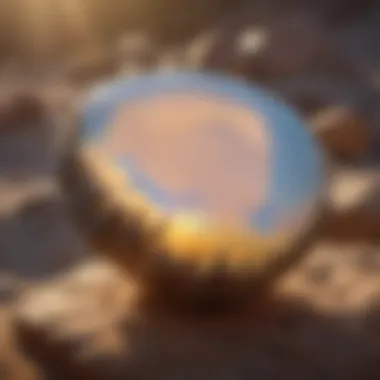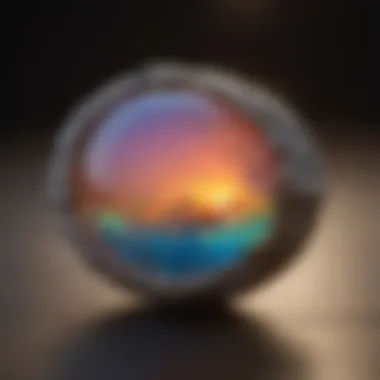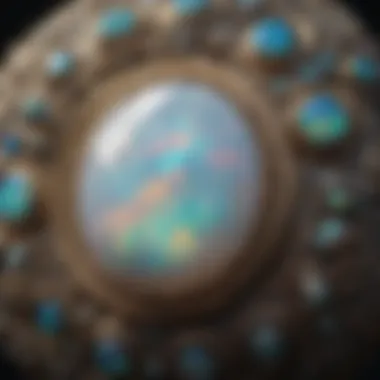Unlocking the Enigma: How to Determine the Authenticity of Opals


Rock and Fossil Identification
Opals, magnificent gemstones, are among the most captivating treasures of the Earth's crust. Examining the authenticity of opals requires a keen eye 🧐 and a few investigative techniques. Real opals possess unique characteristics that set them apart from their simulated counterparts. To determine if an opal is genuine, one must pay attention to key features such as its play of color, transparency, and overall texture. Various tools, including UV lights and magnifying loupes, can aid in the identification process, shining a light on the intricate details of these mesmerizing gemstones.
Collecting Tips and Techniques
Delving into the world of opal collecting unveils a realm of possibilities for enthusiasts. To embark on a successful opal collection endeavor, it is crucial to understand the best practices and techniques involved. From identifying prime collecting sites renowned for their opal deposits to safely extracting specimens without causing damage, collectors must arm themselves with knowledge and precision. By adopting proper collection methods and honing their skills, individuals can elevate their opal collection to new heights of excellence.
Preservation and Display
Preserving the beauty and integrity of opals is a meticulous task that demands careful attention to detail. Techniques vary, but proper storage methods, such as storing opals in protective cases away from direct sunlight and extreme temperatures, are essential for maintaining their brilliance. When it comes to displaying opals, creativity knows no bounds. From elegant jewelry settings to artistic showcases, opals can be presented in ways that accentuate their natural splendor and allure.
Geological Insights
Opals owe their existence to the complex interplay of geological formations and processes over millennia. Understanding the geological origins of opals provides insight into their formation and distribution across the globe. Furthermore, exploring the historical significance of opals sheds light on their cultural and economic impact throughout different eras. Notable discoveries in the field continue to unearth new facets of opal knowledge, expanding our understanding of these captivating gemstones.
Understanding Opals
Opals are fascinating gemstones that captivate with their unique beauty and ethereal charm. In the realm of geology and gemology, understanding opals is crucial for enthusiasts as it unveils a world of iridescence and mystery. By comprehending the formation process, chemical composition, and various types of opals, collectors gain a profound appreciation for these gemstones. Moreover, delving into opals allows collectors to distinguish between genuine opals and their imitations, enabling them to make informed decisions when adding these jewels to their collection.
What are Opals?
Opals are silica-based mineraloids formed from hydrated amorphous silica spheres. These spheres create the play of color phenomenon that opals are renowned for. Opals vary in composition and can contain up to 20% water. This unique water content gives opals their mesmerizing appearance and makes them one of the most intriguing gemstones in the world.


Types of Opals
Opals come in several varieties, each exhibiting distinct characteristics. Common types of opals include precious opals, fire opals, black opals, and white opals. Precious opals are distinguished by their play of color, whereas fire opals exhibit vibrant red, orange, or yellow hues. Black opals, on the other hand, feature a dark body tone that enhances their play of color. White opals are known for their light body tone, making their colors appear softer and more delicate. Understanding the different types of opals helps collectors appreciate the vast diversity within the opal family and aids in identifying the specific characteristics of each type for authentication purposes.
Characteristics of Genuine Opals
The significance of understanding the characteristics of genuine opals cannot be overstated in the realm of gemstone appreciation. Real opals possess unique qualities that set them apart from imitations, making it imperative for collectors and enthusiasts to delve deep into these distinguishing features. By grasping the nuances of real opals, individuals can elevate their knowledge and appreciation for these mesmerizing gemstones. The key elements to look for in genuine opals include play of color, color saturation, and transparency, each playing a crucial role in determining the authenticity and value of the stone.
Play of Color
One of the most iconic features of opals, the play of color, is a mesmerizing display of spectral hues that dance across the surface of the stone. This phenomenon occurs due to the diffraction of light through the silica spheres within the opal, resulting in a stunning array of colors that change with the angle of viewing. Genuine opals exhibit a vibrant play of color that appears organic and fluid, unlike the static and artificial colors seen in many imitations. Collectors should look for a play of color that is rich, dynamic, and harmonious, reflecting the opal's natural beauty and iridescence.
Color Saturation
Color saturation is another critical aspect when assessing the authenticity of opals. Genuine opals display intense and saturated colors that imbue the stone with depth and radiance. The colors should be vivid and evenly distributed, with no patches of dullness or inconsistency. High-quality opals boast a saturation that captivates the eye and enhances the overall visual appeal of the gemstone. By scrutinizing the color saturation of an opal, collectors can discern whether they are holding a true opal treasure or a clever imitation.
Transparency
Transparency plays a pivotal role in differentiating real opals from counterfeit counterparts. Genuine opals exhibit a certain level of transparency that allows light to penetrate the stone, contributing to the play of color and overall brilliance. One should be able to see through the layers of the opal to some extent, observing the intricate patterns and colors within. While opals may vary in transparency depending on their type and quality, authentic opals typically possess a certain degree of translucency that lends them a magical and ethereal quality. By examining the transparency of an opal, collectors can gain valuable insights into its authenticity and craftsmanship.
Identifying Genuine Opals
Identifying Genuine Opals plays a crucial role in the realm of opal appraisal and collection. With the market flooded with imitations and synthetic counterparts, distinguishing authentic opals becomes paramount. Authentic opals possess unique characteristics that set them apart from their less valuable counterparts, making it essential for enthusiasts to develop the skill of identifying real opals. Through a combination of observation, testing, and consultation with experts, individuals can ensure they are investing in genuine gemstones.


The Scratch Test
The Scratch Test stands as a fundamental method in the toolkit of opal authentication. By subjecting the opal to light scratching using a sharp object, individuals can assess its hardness and durability. Genuine opals, known for their delicate nature, should not exhibit scratches or marks from this test. Conducting the Scratch Test requires precision and care to avoid damaging the gemstone inadvertently. Enthusiasts should perform this test under adequate lighting to clearly observe any changes on the surface of the opal.
Examination under Light
Examination under Light serves as a critical evaluation technique to determine the authenticity of opals. Genuine opals display a mesmerizing play of color when illuminated from different angles, a phenomenon known as opalescence. By examining the gemstone under various light sources, such as natural sunlight or LED light, collectors can observe the play of color and internal structure of the opal. This inspection method requires a keen eye for detail and a controlled environment to accurately assess the opal's properties. Understanding how light interacts with the gemstone enables collectors to confirm its genuineness and appreciate its unique beauty.
Common Opal Imitations
Opals, with their mesmerizing play of color and iridescence, have long captivated collectors and enthusiasts in the realm of gemstones. In the pursuit of acquiring authentic opals, it is crucial to understand the nuances of common opal imitations that populate the market. Recognizing the prevalent imitations not only safeguards collectors against counterfeit purchases but also enhances their appreciation for genuine opals. Discussing common opal imitations within this article exemplifies a commitment to thoroughness and accuracy. By shedding light on the characteristics, benefits, and considerations associated with these imitations, rock and fossil enthusiasts are equipped with valuable knowledge necessary to navigate the nuanced world of opals effectively.
Glass Imitations
Glass imitations pose a prevalent threat to opal collectors due to their deceptive resemblance to authentic opals. Crafted meticulously to mimic the play of color and translucency of genuine opals, glass imitations require a keen eye and expert knowledge to differentiate. Understanding the methods used in creating glass imitations, such as the infusion of artificial dyes to replicate opal colors, is essential for collectors seeking to make informed purchasing decisions. By dissecting the characteristics and telltale signs of glass imitations, this section aims to empower collectors with the discernment necessary to identify and appreciate true opals amidst a sea of counterfeits.
Synthetic Opals
In an era of advancing technology, the production of synthetic opals has proliferated, presenting a formidable challenge to authenticity verification. Synthetic opals, composed of similar chemical components as natural opals, exhibit striking visual likeness to their authentic counterparts. Distinguishing between synthetic opals and natural opals requires an in-depth understanding of the production processes and inherent differences in their internal structures. By examining the properties unique to synthetic opals, such as consistent coloring and lack of natural imperfections, collectors can refine their expertise in identifying these manufactured gemstones. This section delves into the intricate world of synthetic opals, offering invaluable insights for rock and fossil enthusiasts intent on curating a genuine opal collection.
Expert Tips and Recommendations
The section of Expert Tips and Recommendations plays a vital role in this comprehensive guide on distinguishing real opals from imitations. By sharing insights from seasoned professionals and enthusiasts, this segment aims to equip rock and fossil collectors with invaluable knowledge and strategies. Through expert tips, readers can navigate the nuanced world of opals with confidence and precision. These recommendations offer a distinctive advantage by shedding light on uncommon aspects, rare findings, and lesser-known facts surrounding opals.


To consult with professionals in the field of opals is to tap into a wealth of expertise and experience. Professionals bring a wealth of knowledge derived from practical hands-on experience and industry insights. Their guidance can help enthusiasts make informed decisions when it comes to identifying authentic opals. By engaging with professionals, collectors can learn about the latest trends, emerging practices, and regional variations that contribute to the overall understanding and appreciation of opals.
Investing in reliable sources is a cornerstone of acquiring genuine opals. Rock and fossil collectors should prioritize sourcing their gemstones from reputable dealers, auctions, or authenticated online platforms. Reliable sources not only guarantee the authenticity of opals but also offer insights into their provenance and quality. By investing in trusted sources, enthusiasts safeguard themselves against counterfeit products and ensure the long-term value of their collections.
Caring for Authentic Opals
In the grand realm of opals, caring for these radiant gemstones stands as a paramount duty for any passionate collector or admirer. Among the myriad aspects surrounding opals, their care and maintenance play a crucial role in preserving their beauty and longevity. Authentic opals, with their exquisite play of color and unique characteristics, deserve meticulous attention to ensure they remain in pristine condition over time. Understanding the significance of caring for authentic opals is not merely a routine task but a commitment to upholding the essence and essence and splendor of these natural treasures.
Storage Tips
When considering the storage of authentic opals, one must take into account the delicate nature of these gemstones and their susceptibility to external influences. Optimal storage conditions involve keeping opals away from harsh elements such as direct sunlight, heat, and chemicals, which can potentially tarnish or damage their surface. Utilizing soft, padded containers or cloth pouches offers a protective shield against scratches and abrasions, safeguarding the opals' polished finish and luster. Additionally, storing opals individually or in compartments can prevent them from rubbing against other jewelry pieces, reducing the risk of unwanted wear and tear.
Cleaning Techniques
Maintaining the radiance of authentic opals requires a gentle and methodical approach to cleaning. To preserve their vibrancy and brilliance, it is essential to avoid harsh chemicals or abrasive substances that may harm the opal's surface. Instead, opt for mild soap and lukewarm water to cleanse the gemstones, gently wiping them with a soft cloth to remove any dirt or residues. Avoiding prolonged exposure to water and ensuring thorough drying can prevent water damage and discoloration. Regular cleaning sessions not only restore the opals' natural allure but also contribute to their longevity and durability, allowing collectors to savor the opals' captivating beauty for generations to come.
Conclusion
In the vast and enchanting realm of opals, the conclusion serves as a crucial juncture where clarity and discernment come together. As we navigate the complexities of distinguishing between real opals and their imitations, the conclusion emerges as a beacon of consolidation. It encapsulates the essence of our exploration, weaving together the pivotal threads that define authenticity in opals. Through a meticulous examination of key characteristics, fervent collectors can unveil the intrinsic beauty of genuine opals while sidestepping the allure of counterfeit gems.
Conclusively, the importance of the conclusion in this enlightening article reverberates with echoes of knowledge. It steers us towards a definitive understanding, offering a roadmap to traverse the intricate labyrinth of opal authenticity. By delving into the multifaceted world of opals and deciphering the subtle nuances that set real opals apart, collectors arm themselves with a shield of expertise. In a landscape rife with replicas, the conclusion stands as a bastion of truth, guiding enthusiasts towards the prized possession of authentic opals.
Ensuring the Authenticity of Opals
The significance of ensuring the authenticity of opals cannot be overstated – it is the cornerstone upon which the entire opal industry rests. As avid enthusiasts and discerning collectors delve into the enigmatic world of opals, the importance of distinguishing genuine opals from their synthetic counterparts becomes paramount. In an age where imitation runs rampant, knowing how to ascertain the true nature of these mesmerizing gemstones is essential.
To unravel the authenticity of opals, one must embark on a journey of scrutiny and meticulous evaluation. By honing in on key characteristics such as the pronounced play of color, impeccable color saturation, and unparalleled transparency, collectors equip themselves with the tools necessary to discern real opals. The process necessitates a keen eye and unwavering attention to detail, as each subtle nuance plays a pivotal role in unraveling the mysteries of opal authenticity.
Furthermore, consulting with seasoned professionals and investing in reputable sources serve as guiding beacons in the quest for authentic opals. By leveraging the expertise of authorities in the field and leveraging reliable avenues for opal acquisition, enthusiasts fortify their knowledge and shield themselves against falling prey to clever imitations.
In essence, ensuring the authenticity of opals transcends mere validation; it embodies a quest for truth and a celebration of the genuine. By upholding the standards of authenticity and immersing oneself in the nuances of opal evaluation, collectors not only enhance their collections but also preserve the integrity of the enthralling world of opals.







